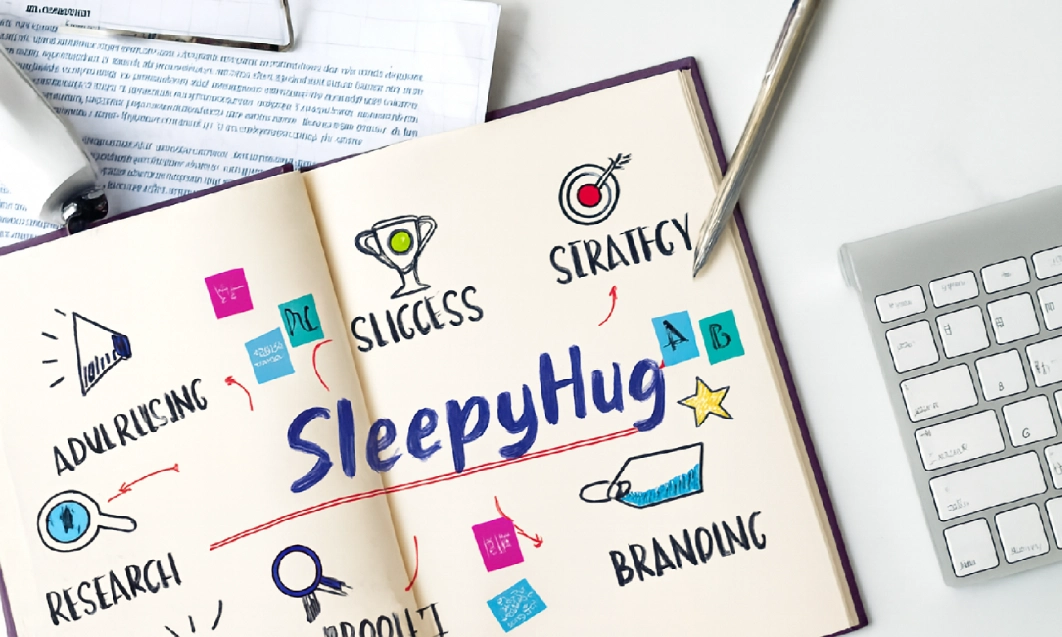Entrepreneur Success Story: How SleepyHug Scaled with Purpose and Precision

Ever wondered what separates a fleeting startup from a category-defining brand?
The real game-changer is when you align mission-driven purpose with ruthless operational precision. A combination that's rare, powerful, and exactly what propelled SleepyHug from concept to a ₹100 Cr ARR sleep-wellness brand in just 13 months.
Think about it: India's mattress market was crowded, commoditised, and frankly, exhausting for consumers. Yet within this chaos, SleepyHug identified a whitespace - science-backed orthopedic comfort at transparent pricing, delivered fast - and built an empire around it.
So how did they do it? What made this entrepreneur's success story different from the hundreds of D2C brands that launch with fanfare but fizzle out?
Let's break down the playbook.
SleepyHug at a glance: The numbers that matter
Before we dive deep, here's what this SleepyHug case study delivered in raw metrics:
- ARR growth: ₹0 to ₹100 Cr run-rate in approximately 13 months
- SKU expansion: Started with 39 SKUs, scaled to 500+ (mattresses plus accessories like pillows, protectors, and bedsheets)
- Geographic coverage: 20,000+ pincodes served across India
- Delivery speed: 48-hour delivery in metro cities via regional warehouses
- Logistics partners: Multi-partner network including Delhivery and XpressBees
- Return cost optimisation: Reduced from ₹2,600-₹2,800 to approximately ₹1,500
- Marketing efficiency: Monthly spend scaled from ₹1.3 lakh to ₹12-14.5 lakh while maintaining strict CAC/ROAS guardrails
A purpose-driven mission that anchored everything
Every successful entrepreneur's success story begins with a problem worth solving. For SleepyHug, that problem was glaringly obvious yet consistently ignored by the industry.
Why did India need SleepyHug?
Consider this: Over 60% of Indians still sleep on unbranded, low-quality mattresses. The alternatives? Either expensive legacy brands inflated by retail markups, or generic memory foam boxes from new-age D2C players that promised the moon but delivered discomfort.
Consumers wanted three things:
- Science-backed sleep solutions (orthopaedic support, cooling technology, spinal alignment)
- Honest, transparent pricing (no hidden dealer markups)
- Trustworthy delivery and service (fast fulfilment, easy returns, genuine warranties)
But here's what set SleepyHug apart: they didn't position themselves as just another mattress seller. Instead, they became India's sleep-wellness partner, a brand whose mission was to make restful sleep accessible to all.
SleepyHug's Team: "We didn't aim to be cheapest; we engineered better rest-accessibly."
The SleepyHug case study is as much about overcoming operational shocks as it is about growth hacks.
What nearly broke SleepyHug?
1. Third-party logistics (3PL) failures
Early on, SleepyHug relied on a 3PL partner for fulfilment. Sounds reasonable, right? Wrong. During peak demand (think Diwali sales), the partner's operational inefficiencies led to:
- ₹4–5 Cr worth of inventory stuck in warehouses
- 90% of COD orders delayed or blocked
- Rising customer complaints about late deliveries
The team took legal action, physically retrieved inventory using 12–15 trucks, and switched to reliable logistics partners like Delhivery and XpressBees. Crisis averted, but the lesson was clear: operations aren't a back-end function; they're brand promises made tangible.
2. High return rates and TAT delays
In the beginning, SleepyHug faced a 20% return rate on Amazon - a nightmare for margins and customer trust.
The fix? SleepyHug rebuilt the system:
- Set up 6 regional warehouses for faster TAT (reduced to 6-7 days)
- Improved product packaging and quality controls at the factory level
- Created educational infographics to help customers measure and select the right mattress
Result: Return rates dropped to 5–6%, and customer satisfaction scores soared.
3. Pricing missteps and cash burn risks
Like many startups, SleepyHug initially misjudged pricing elasticity. Early attempts to raise prices to compensate for losses backfired.
Then came the opposite problem: aggressive performance marketing pushed marketing costs to 29% of revenue (way above the sustainable 3–5% benchmark).
The wake-up call? Unit economics over vanity metrics. SleepyHug shifted focus to:
- Blended CAC (Customer Acquisition Cost) tracking
- Category-level and SKU-level CAC analysis
- TACOS (Total Advertising Cost of Sale) instead of ACOS
By disciplining spend and optimising organically-driven sales (eventually restoring 80-90% organic contribution), SleepyHug proved that growth without discipline is just noise.
The strategy: Purpose x precision across four engines
This is where the SleepyHug case study gets interesting. Most brands focus on one pillar - their product innovation or marketing efficiency or operational excellence.
SleepyHug? They aligned all four engines simultaneously:
- Product and brand
- Pricing and growth efficiency
- Operations as a moat
- Data, automation, and decisioning
1. Product and brand: Building trust through innovation
SleepyHug's product line was engineered around specific consumer pain points:
- AirCell Cooling Technology: A honeycomb foam structure that maximises airflow, preventing heat retention (the #1 complaint about memory foam)
- Orthopaedic Spinal Alignment: Multi-layer construction ensuring proper posture and pressure relief
- Motion Isolation: Minimising partner disturbances for couples
- Durability: High-density foam that resists sagging, backed by robust warranties
Additionally, SleepyHug's brand identity wasn't accidental. Every touchpoint reinforced the sleep-wellness mission:
- Logo colours: Green and orange (India's tricolour) signalling "Made in India, Made for India"
- Messaging: Emphasising rest, rejuvenation, and health benefits (not just product features)
- Customer service: 24/7 multilingual support, hassle-free returns, transparent warranty claims
This consistent positioning built emotional equity; customers were investing in better health.
2. Pricing and growth efficiency: Scaling without burning out
Here's a truth bomb: most D2C brands die from cash burn, not lack of demand.
SleepyHug avoided this trap through disciplined pricing and marketing spend management.
Using Intellsys.ai's Pricing Recommender, SleepyHug tracked 22,000+ real-time product prices across Amazon, Flipkart, and competitor websites. This enabled:
- Competitive benchmarking: Ensuring SleepyHug's pricing remained attractive without sacrificing margins
- Dynamic Price adjustments: Tweaking prices based on sales velocity, competitor moves, and ad performance
- Profitability optimisation: Balancing customer acquisition with healthy unit economics
SleepyHug's marketing spend evolution is a masterclass in scaling responsibly:
Month 1-3: ₹1.3 lakh/month (lean, awareness-focused campaigns on Amazon)
Month 4-8: Gradual increase to ₹11.5–14.5 lakh/month as revenue targets grew
CAC guardrails: Every budget increase was justified by ROAS and customer payback metrics
Pause on decay: When diminishing returns appeared (e.g., the May–June "performance marketing breach"), the team immediately scaled back
At its peak efficiency, SleepyHug achieved 80-90% organic sales, meaning only 10–20% came from paid ads. The company targeted influencer and referral marketing strategies for scale.
3. Operations as a moat: Turning logistics into competitive advantage
Most brands treat operations as a necessary evil. SleepyHug turned it into a strategic moat.
SleepyHug built a multi-node warehouse network spanning 9 fulfilment centres across 5 cities. They focused on optimising their supply chain.
This was about speed and reliability. In a category where delivery experience directly impacts brand trust, SleepyHug made sure customers never waited longer than promised.
SleepyHug also focused on their customer experience and stood behind every purchase:
- Multilingual support: AI-powered chatbots + human agents available round-the-clock
- Proactive issue resolution: NDR (Non-Delivery Report) management via WhatsApp, email, and phone
- Streamlined returns: Reduced return cost from ₹2,600–₹2,800 to ₹1,500 through process improvements
- Transparent warranty claims: Following Amazon A-to-Z guidelines to prevent escalations
These seemingly small operational details? They're what separated SleepyHug from competitors who treated customer service as an afterthought.
4. Data, automation, and decisioning: The AI-powered backbone
Here's where the SleepyHug case study serves as a blueprint for modern D2C brands by leveraging enterprise analytics.
SleepyHug used Intellsys.ai, GrowthJockey's AI-driven marketing intelligence platform, to:
- Track 1,000+ metrics from 200+ data sources (ad platforms, marketplaces, website analytics, ERP)
- Process 15 million data points per second
- Generate real-time dashboards for pricing, ad performance, profit margins, stock levels
Why does this matter? Because in D2C, speed of decision-making separates winners from losers. When SleepyHug spotted a pricing opportunity or a stock shortage, they acted within hours.
In addition to that, SleepyHug deployed OttoPilot (GrowthJockey's business automation suite) to:
- Automate lead capture and follow-ups: Ensuring no potential customer fell through the cracks
- Unified lead tracking: Consolidating data from website, email, and social ads
- Real-time sales intelligence: Live dashboards showing order stage, conversion likelihood, and product SKU performance
- Seamless tool integrations: Syncing CRM, email platforms, and marketing automation
Sales teams spent less time on manual tasks and more on relationship-building.
Founder and operator playbook: Lessons from SleepyHug
If you're building a D2C brand, an e-commerce venture, or any high-growth business, here's what the SleepyHug case study teaches:
1. Anchor in purpose
Let your mission shape product decisions, pricing, and policies. SleepyHug championed sleep wellness. This clarity permeated everything from brand messaging to customer service.
Define your "why" in one sentence. If it doesn't guide daily decisions, refine it until it does.
2. Instrument everything
Live P&L + inventory visibility = competitive advantage. SleepyHug tracked 1,000+ metrics from 200+ sources continuously. This enabled real-time course corrections instead of reactive firefighting.
Implement dashboards that integrate marketing, sales, and operations data. If you can't see it, you can't manage it.
3. Treat operations as a brand
Warehouse topology, SLAs, and return economics are marketing. SleepyHug's 48-hour delivery promise wasn't advertising; it was operational excellence made tangible.
Audit your logistics, packaging, and support processes. Where do they fall short of your brand promise? Fix those gaps first.
4. Scale assortment deliberately
Phase SKUs with cross-sell logic and quality bars. SleepyHug validated demand, tested variants, and ensured each SKU served a strategic purpose (higher AOV, customer retention, market expansion).
Before launching a new product, ask: Does it solve a customer problem? Does it increase lifetime value? Can we maintain quality at scale?
5. Spend with brakes
Raise marketing budgets only when CAC/ROAS hold; pause on diminishing returns. SleepyHug's disciplined spend management prevented cash burn while maximising growth efficiency.
Set CAC ceilings and ROAS floors for every campaign. If a channel drifts out of bounds, cut it immediately, even if it hurts short-term topline.
Closing thoughts: SleepyHug success story
This isn't just an entrepreneur success story about hitting revenue milestones. It's a framework for building brands that matter - brands that solve real problems, earn customer trust, and scale responsibly.
Here's the core truth: You can't fake your way to ₹100 Cr ARR. You need:
- Purpose that anchors every decision (sleep wellness, not just mattress sales)
- Precision across product, pricing, operations, and data (no room for guesswork)
- Discipline to pause spending when returns diminish (growth without burn)
- Resilience to turn crises into systems upgrades (3PL failures → multi-partner logistics)
If you're an entrepreneur, D2C operator, or growth leader looking to scale with clarity and control, reach out to our venture architects at GrowthJockey.
Let's turn your vision into a category-defining brand - purposefully and precisely.
FAQs
Q1. How fast did SleepyHug hit a meaningful scale?
SleepyHug reached approximately ₹100 Cr ARR in 13 months by pairing SKU expansion, disciplined marketing spend, and operational readiness.
Q2. How were returns made affordable?
SleepyHug reduced return costs from ₹2,600–₹2,800 to ₹1,500 through:
- Improved packaging and product quality
- Educational content (sizing guides, firmness selectors)
- Faster TAT via regional warehouses
- Strategic logistics negotiations








